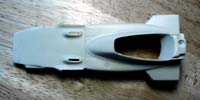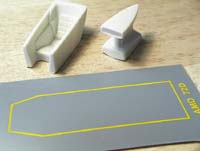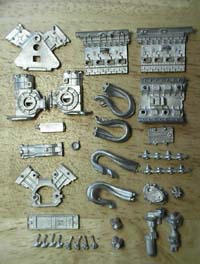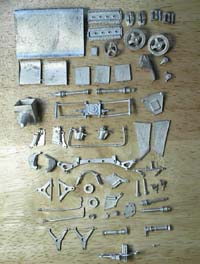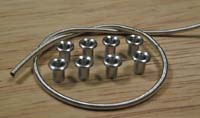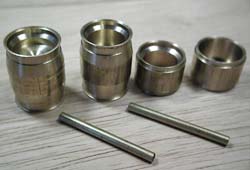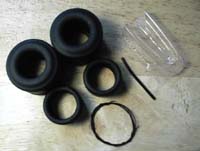AMD 1/20 Lotus 72D Multi-Media Kit | 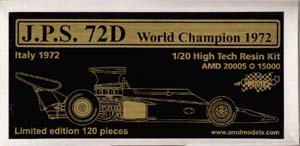 | Introduction This is a 1/20th scale, kit of resin, white metal, and photo-etch from the Brazilian manufacturer AMD. Tamiya molds this same car in a 1/12th scale kit, but this is the only Lotus 72D in 1/20th scale that I know of. The Lotus 72 was designed by Maurice Phillippe under the close supervision of the great Colin Chapman. The Lotus 72 was one of the most famous and successful cars in Formula 1 history. It participated in as many as six seasons, and 74 races that included 20 victories, two Drivers World Championships and three Constructors World Championships. This impressive list of accomplishments was unsurpassed for more than a decade. The Lotus 72 was innovative in many revolutionary ways, as was the norm for Colin Chapman, one of the biggest innovators in Formula 1 history. First, the car had a unique wedge shape. To improve weight distribution and aerodynamic flow the front radiator was split into two and relocated on each side of the cockpit. The front suspension was also designed with 'anti-dive' geometry to limit the nosedive under braking, a flaw in the previous Lotus 49. The rear suspension was designed with anti-squat geometry to limit the tendency for the nose to rise under acceleration. The other major innovation pushed forward by Colin Chapman and the Lotus 72 was the introduction of the air scoop, an aerodynamically shaped air intake that is sealed to the engine inlet stacks which increases the air inlet speed and pressure to the engine increasing horsepower. The Lotus 72 debut in April of 1970 and was driven by Jochen Rindt and John Miles. The car did not perform well at that race in Spain or the following week at Silverstone. The car went back to the Lotus factory for some major revisions. The result was the Lotus 72B which had the anti-squat removed and the 72C which had both the anti-squat and anti-dive removed. Colin Chapman did acknowledge later he wished the team had stuck with the original design longer. Rindt went on to drive the 72C to four consecutive victories. The car and team were riding high until the tragic death of Jochen Rindt during practice at the famous Parabolic corner at the Italian track Monza. A very young Emerson Fittapaldi replaced Rindt and went on to win at Watkins Glen securing World Championships for both Rindt and Lotus. The following year 1971, the death of Rindt was still a dark cloud over the team. Emerson Fittipaldi was injured in a road car accident and the team only managed a handful of podium finishes and no victories. Perhaps due to the team's lackluster performance, changes were being pushed forward and by the end of the year the team introduced the 72D. The oil tank was redesigned and a new one piece rear wing was fitted. The rear suspension was also modified, removing a radius rod and the lower wishbone was replaced with parallel links. The beginning of the 72 season saw the car debut with the now famous black and gold 'John Player Special' livery. Just as 1971 was a bad year where nothing went right 1972 was the opposite. Perhaps it was the new livery, as Emerson Fittipaldi, the youngest driver in Formula 1 at 25, went on to win five races and claim the Drivers World Championship. This kit is modeled to represent the 72D driven by Emerson Fittipaldi at the Italian Grand Prix at Monza where, despite the Lotus transporter accident that damaged both cars in route to Monza, Fittipaldi clinched the Championship in a spare that was hastily shipped just in time from England. The kit This is AMD's fifth release, kit #20005. As noted in a previous AMD First Look review, their themes all have Brazilian flavor and in this case it is none other than the great Brazilian Emerson Fittipaldi. The kits contents include a one piece solid resin body, two photo-etch sprues, rubber tires, a vacuform windvisor, a set of turned air intake stacks, some brass tubing for exhausts, a resin cast seat and top air intake scoop and two bags of white metal parts. One bag of white metal parts contains the Ford Cosworth DFV engine pieces, which look to cast from a Tamiya kit. The other bag of white metal is larger and contains the suspension pieces, rear wing, and other odds and ends. The kit also contains a set of absolutely gorgeous turned brass wheels. The photo-etch pieces include the dash, rear and front brake rotors, seat belt hardware, dzus fastners, wheel clips, wheel weights, mirror faces and wing end plates. The decals look excellent and contain the all gold pin stripes needed, the John Player Special logos, gauge faces, seat belt logos, driver logos, Firestone tire decals with gold tire trim and other assorted sponsor logos. Included on this sheet are additional decals should the builder want to build the car as it ran at other races in 1972 or in early 1973. There is also a small extra set of Goodyear logos for these alternate builds and another sheet of numbers (1-9 and 0) in correct font for alternate builds. The instructions are excellent. They consist of an eleven page, 5 1/2 x 8" booklet. The front and back pages contain an introduction and a few pictures of the built kit printed in color. The first two pages has a drawing of all the parts contained in the kit with their according part number, R for resin pieces, E for etch pieces, and M for metal pieces. Check and make sure you got everything. The next six pages guide you through the build and the last page show the decal placement. The instructions are complete with detailed painting instructions. The decals are some of the best I have seen for a larger resin kit. The color photos of the completed build are also a very nice addition. Conclusions The resin castings are excellent. A little clean up around the edges will be needed but they are sharp and crisp. All the detail is there, a full engine with a lift-off air intake. This is a historically significant Formula 1 car that should be part of everyoneís collection. The kit isn't for the beginner and it is a true multi-media kit, bring all your various glue types for this one. This kit also isn't for beginners because of its whopping going rate price of around $150. This AMD release is better than the last AMD kit reviewed by me, the Brabham BT44b. It appears as though AMD is really making strides to bring you a higher and higher quality kit with every release. The brass wheels are a piece of art and add to that turned velocity stacks and this kit is better than some of the Studio 27 kits I have seen. If you haven't seen the AMD line up of kits take a look at their website. The AMD website also contains a variety of pictures of the car at various races as well as some detail shots you may need to correctly place the rear wing rake. They also have a list of world wide distributors of AMD kits, future releases and reference material. I know here in the states they are available from TnT hobbies. AMD has announced their upcoming 2001 releases and it's an impressive list of seven or eight kits! This list includes Aryton Sennaís first test ride in the Williams FW08 and the novel Williams FW08 6-Wheeler. In addition to these their new release list contains three evolutions of the McLaren MP4/1. Quite an exciting list of releases to look forward to! | 


 



  
    |
